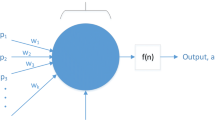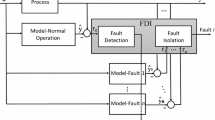Abstract
In this chapter the problem of identing events in dynamic processes (e.g., faults, anomalous behaviours, etc.) is tackled with soft computing techniques aimed at the classification of the process transients generated by such events. A review of previous work is followed by a discussion of several alternative designs and models which employ both fuzzy and neural systems. These have been developed during an ongoing reserch program which was initiated by the need of finding new principled methods to perform alarm structuring/suppression in a nuclear power plant alarm system. This initial goal was soon expanded beyond alarm handling, to include diagnostic tasks in general. The application of these systems to domains other than NPPs was also taken into special consideration. A systematic study was carried out with the aim of comparing alternative neural network designs and models. Four main approaches have been investigated: radial basis function (RBF) neural networks and cascade-RBF neural networks combined with fuzzy clustering, self-organizing map neural networks, and recurrent neural networks. The main evaluation criteria adopted were: identification accuracy, reliability (i.e., correct recognition of an unknown event as such), robustness (to noise and to changing initial conditions), and real time performance. A series of initial tests on a small set of BWR transients was recently followed by more advanced tests on PWR transients corresponding to various occurrences of rapid load rejection events (plant islanding). The chapter is closed by a discussion of open issues and future directions for research and applications.
Access this chapter
Tax calculation will be finalised at checkout
Purchases are for personal use only
Preview
Unable to display preview. Download preview PDF.
Similar content being viewed by others
References
N.T. Ferdestrommen, B.R. Mourn, B. Torralba, C. Decurnex, “CASH: An Advanced Computerized Alarm System”, in Proceedings of the ANS-meeting, Philadelphia, Pennsylvania, USA, June 1995.
T.S. Brendeford “General Knowledge Structure for Diagnosis”, in Proceedings of the IAEA’s specialist’s Meeting on Monitoring and Diagnosis Systems to Improve Nuclear Power Plant Reliability and Safety, Barnwood, UK, 14–17 May 1996.
P. Fantoni, A. Serenssen, and G. Mayer “CAMS: A Computerised Accident Management System for Operator Support During Normal and Abnormal Conditions in Nuclear Power Plants”, in Proceedings of the Second OECD Specialist Meeting on Operator Aids for Severe Accident Management (SAMOA-2), September 1997.
P.F. Fantoni and A. Mazzola, “Multiple-Failure Signal Validation in Nuclear Power Plants using Artificial Neural Networks”, Nuclear Technology, March 1996.
P.F. Fantoni, “Neuro-Fuzzy Models Applied to Full Range Signal Validation in Nuclear Power Plants”, ANS International Topical Meeting on Nuclear Power Plant Instrumentation, control and Human Machine Interface, The Pennsylvania State University, 1996.
P.F. Fantoni, S. Figedy, A. Racz, B. Papin, “A Neuro-Fuzzy Model Applied to Full Range Signal Validation of PWR Nuclear Power Plant Data”, inProceedings of FLINS’98, the 3rd International FLINS Workshop on Fuzzy Logic and Intelligent Technologies for Nuclear Science and Industry, Antwerp, Belgium, September 1998.
E.B. Bartlett and R.E. Uhrig, “Nuclear Power Plant Status Diagnostics Using an Artificial Neural Network”, Nuclear Technology, Vol. 97, 1992, pp. 272–281.
A. Basu and E.B. Bartlett, “Detecting Faults in a Nuclear Power Plant by Using a Dynamic Node Architecture Artificial Neural Network”, Nuclear Science and Engineering, Vol. 116, 1995.
Y. Bartal, J. Lin, and R.E. Uhrig, “Nuclear Power Plant Transient Diagnostics Using Artificial Neural Networks that Allow ”Don’t-Know“ Classifications”, Nuclear Technology, Vol. 110, 1995.
H. Furukawa, T. Ueda, and M. Kitamura, “Use of Self-Organizing Neural Networks for Rational Definition of Plant Diagnostic Symptoms”, Proceedings of the International Topical Meeting on Computer-Based Human Support Systems: Technology, Methods, and Future, The American Nuclear Society Inc., La Grange Park, IL, 1995, pp. 441–448.
E. Jeong, K. Furuta, S. Kondo, “Identification of Transient in Nuclear Power Plant Using Neural Network with Implicit Time Measure”, Proceedings of the International Topical Meeting on Computer-Based Human Support Systems: Technology, Methods, and Future, The American Nuclear Society Inc., La Grange Park, IL, 1995, pp. 467–474.
E. Jeong, K. Furuta, S. Kondo, “Identification of Transient in Nuclear Power Plant Using Adaptive Template Matching with Neural Network”, Proceedings of the International Topical Meeting on Nuclear Plant Instrumentation, Control, and Human-Machine Interface Technologies, NPICandHMIT’96, The American Nuclear Society Inc., La Grange Park, IL, 1996, pp. 243–250.
Y. Ohga, S. Arita, T. Fukuzaki, N. Takinawa, Y. Takano, S. Shiratory, and T. Wada, “Evaluation Test of Event Identification Method Using Neural Network at Kashiwazaki Kariwa Nuclear Power Station Unit No.4”, Journal of Nuclear Science and Technology,Vol. 33, No. 5, 1996, pp. 439447.
K.C. Kwon, C.S. Ham, and J.H. Kim, “An Application of Hidden Markov Model to Transient Identification in Nuclear Power Plants”, Proceedings of the International Topical Meeting on Computer-Based Human Support Systems.’ Technology, Methods, and Future, The American Nuclear Society Inc., La Grange Park, IL, 1995, pp. 275–280.
K.C. Kwon and C.S. Ham, “A Stochastic Approach with the Hidden Markov Model for Accident Diagnosis in Nuclear Power Plants”, HRP Workshop on Intelligent Decision Support Systems for Emergency Management, Halden, Norway, 1997.
M.H. Hassoun, Fundamentals of Artificial Neural Networks, The MIT Press, Cambridge, 1995.
J.T. Tou and R.C. Gonzalez, Pattern Recognition Principles, p. 97. Addison-Wesley, Reading (MA ), 1974.
J.C. Bezdek, Pattern Recognition with Fuzzy Objective Function Algorithms, Plenum Press, 1981.
R. Krishnapuram and J. Keller, “A possibilistic approach to clustering”, IEEE Transactions on Fuzzy Systems, Vol. 1, No. 2, 1993.
D.S. Broomhead and D. Lowe, “Multivariable functional interpolation and adaptive networks”, Complex Systems, Vol. 2, pp. 321–355, 1988.
S. Chen, C.F.N. Cowan, and P.M. Grant, “Orthogonal Least Squares Learning Algorithm for Radial Basis Function Networks”, IEEE Transactions on Neural Networks, Vol. 2, No. 2, pp. 302309, 1991.
T. Kohonen, Self-Organization and Associative Memory, 3rd edn., Springer-Verlag, Berlin, 1989.
G.J. Chappel and J.G. Taylor, “The Temporal Kohonen Map”,Neural Networks, Vol. 6, pp. 441445, 1993.
T. Koskela, M. Varsta, J. Heikkonen, and K. Kaski, “Time Series Prediction using Recurrent SOM with Local Linear Models”, International Journal of Knowledge Based Intelligent Engineering Systems, 1997.
J.L. Elman, “Finding structure in time”, Cognitive Science, Vol. 14, pp. 179–211, 1990.
Y. Bengio, P. Simard, and P. Frasconi, “Learning Long-Term Dependencies with Gradient Descent is Difficult”, IEEE Transactions on Neural Networks, Vol. 5 (2), pp. 157–166, 1994.
Y. Freund, “Boosting a weak learning algorithm by majority”,Information and Computation, Vol. 121 (2), pp. 256–285, 1995.
Y. Freund and R.E. Shapire, “Experiments with a New Boosting Algorithm”, in Machine Learning, Proceeding of the 13 th International Conference (ICML 196), pp. 148–156, Morgan Kaufmann, Bari (Italy), 1996.
Author information
Authors and Affiliations
Editor information
Editors and Affiliations
Rights and permissions
Copyright information
© 2000 Springer-Verlag Berlin Heidelberg
About this chapter
Cite this chapter
Roverso, D. (2000). Neural and Fuzzy Transient Classification Systems: General Techniques and Applications in Nuclear Power Plants. In: Ruan, D. (eds) Fuzzy Systems and Soft Computing in Nuclear Engineering. Studies in Fuzziness and Soft Computing, vol 38. Physica, Heidelberg. https://doi.org/10.1007/978-3-7908-1866-6_10
Download citation
DOI: https://doi.org/10.1007/978-3-7908-1866-6_10
Publisher Name: Physica, Heidelberg
Print ISBN: 978-3-7908-2466-7
Online ISBN: 978-3-7908-1866-6
eBook Packages: Springer Book Archive




